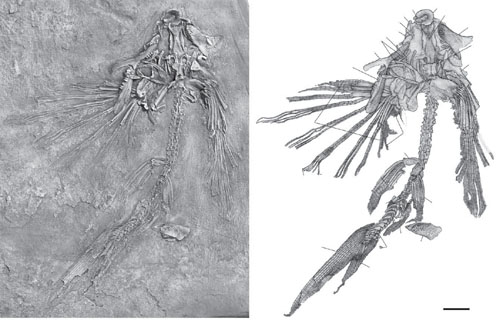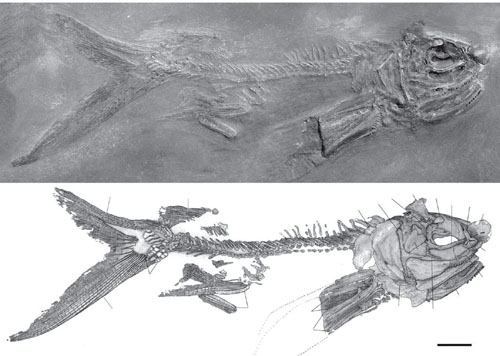Oldest Flying Fish Fossil Found in the Middle Triassic of China
Paleontologists from the Institute of Vertebrate Paleontology and Paleoanthropology (IVPP), Chinese Academy of Sciences, Zhejiang Museum of Natural History and Peking University, reported the discovery of exceptionally well-preserved fossils of a new thoracopterid flying fish from the Middle Triassic of Xingyi City, Guizhou Province, southwest China, which represents the earliest evidence of an over-water gliding strategy in vertebrates. This new discovery extends the geographical distribution of this group from the western to eastern rim of the Palaeotethys Ocean, providing new evidence to support the Triassic biological exchanges between Europe and southern China. Researchers reported online 31 October 2012 in the Proceedings of the Royal Society B.
Flying fishes are extraordinary aquatic vertebrates capable of gliding great distances over water by exploiting their enlarged pectoral fins and asymmetrical caudal fin. This oldest flying fish fossil was named Potanichthys xingyiensis. It is not an ancestor of today's flying fish. Some 50 species of extant flying fishes are classified in the Exocoetidae (Neopterygii: Teleostei), which have a fossil record no older than the Eocene.
Potanichthys is related to a now-extinct family of over-water glider known as thoracopterids, which shows an array of features associated with the capability of over-water gliding. Fossils of these gliders, which lived in the late Triassic, around 200 million years ago, have been found in Italy and Austria. Potanichthys is the only glider found in Asia and it is the oldest, dating tens of millions of years earlier to the middle Triassic.
Potanichthys has a total length of 153 mm. It displays aerodynamic characteristics in having a ‘four-winged’ body plan: a pair of greatly enlarged pectoral fins as ‘primary wings’ and a pair of pelvic fins as ‘auxiliary wings’. The caudal fin is highly asymmetrical and deeply forked, with the ventral lobe noticeably stronger than the dorsal lobe. Swift movement of such a caudal fin could generate the power to launch the fish for over-water gliding.
"Potanichthys and the European thoracopterids probably have a common ancestor", said lead author XU Guanghui of the IVPP, "Although the Austrian thoracopterid has scales, the Italian ones lack them entirely. Potanichthys is on the fence: it has just four rows of scales reaching back to its tail, providing a transition or a missing link between them". The scale reduction in thoracopterid evolution could provide the advantage of manoeuvrability and energy efficiency for gliding.
As the theory goes, fish evolved gliding flight to escape predators, which is supported by the observation that flying fishes are a dominant food source in the stomach contents of dolphins. Thoracopterid flying fishes most probably used gliding as an escape strategy from predators—potentially the co-occurring marine reptiles and large carnivorous fishes. Thus, gliding adaptations in thoracopterid flying fishes represent a remarkable case of convergent evolution of over-water gliding strategy with extant flying fishes.
"The discovery of Potanichthys extends the stratigraphic range of the Thoracopteridae from the Late Triassic to the Middle Triassic, and enriches our knowledge of the ecological complexity in the Middle Triassic (Ladinian) of the Palaeotethys Ocean after the end-Permian mass extinction around 250 million years ago, in which up to 95% of marine life died,” said corresponding author GAO Keqing of Peking University, “This discovery supports the hypothesis that the recovery of marine ecosystems after the end-Permian event was more rapid than previously thought.”
The research was supported by the National Natural Science Foundation of China, Key Laboratory of Evolutionary Systematics of Vertebrates (IVPP, CAS) and State Key Laboratory of Palaeobiology and Stratigraphy (NIGP, CAS). 
Fig.1 Holotype of Potanichthys xingyiensis (ZMNH M1692), scale bar 1 cm. (Image by XU Guanghui) 
Fig.2 A near-complete skeleton of of Potanichthys xingyiensis (IVPP V17744), scale bar 1 cm. (Image by XU Guanghui) 
Fig.3 Reconstruction of the phenotype of Potanichthys xingyiensis. (Image by WU Feixiang)
Download attachments: